This sourdough French bread recipe delivers everything you love about classic French bread and more!
French bread is known for its airy, soft interior and a crisp, golden crust. By using sourdough as a natural leavening agent instead of commercial yeast, this version not only becomes a healthier choice, but also easier to digest, thanks to the extended fermentation process that helps unlock nutrients.
The sourdough enhances the flavor while maintaining the bread’s versatility. With two generous loaves, the options are endless. You can make garlic bread, French bread pizzas, sub sandwiches, or simply enjoy a warm, buttered slice.

What is French bread?
French bread is a classic loaf known for its crisp, golden crust and soft, airy interior. Traditionally made with just flour, water, salt, and yeast, it’s shaped into long, slender loaves, like baguettes or bâtards, and baked to develop that signature crust.
My sourdough version leans into those same characteristics but adds a naturally fermented depth of flavor and a chewier bite, perfect for sandwiches, garlic bread, or tearing apart warm with butter.
Why I love this recipe
I’ve spent nearly two years perfecting this sourdough French bread recipe, baking it many times to capture the exact taste, texture, and look of traditional French bread. While it’s easy to achieve with yeast, sourdough takes it to a whole new level, requiring more precision and patience.
But with every batch, I worked to ensure each element of the classic loaf was just right. Here is why I think you’ll love it as much as I do.
- Sweet levain: My recipe uses a sweet levain which mutes that sour flavor, but still allows for a long fermentation process.
- Taste & texture: The exterior of the French bread is golden and lightly crisp, while the interior boasts a soft, pillowy texture.
- Healthier option: sourdough french bread is 100% sourdough making it easier to digest & a healthier option.
- By hand: Everything is done by hand and no fancy equipment is needed!

Different ways to use sourdough french bread
Sourdough French bread will serve you well and is versatile in many ways. Here are just a few ways we enjoy it.

- French Bread Pizza – Slice the bread in half, add your favorite toppings, and bake for a quick and delicious pizza alternative.
- Sub Sandwich – Use the sturdy, airy loaf to create the perfect base for a hearty sub sandwich, holding all your favorite fillings.
- Garlic Bread – Slice, spread with garlic butter, and toast for a classic side that pairs well with soups or pasta dishes.
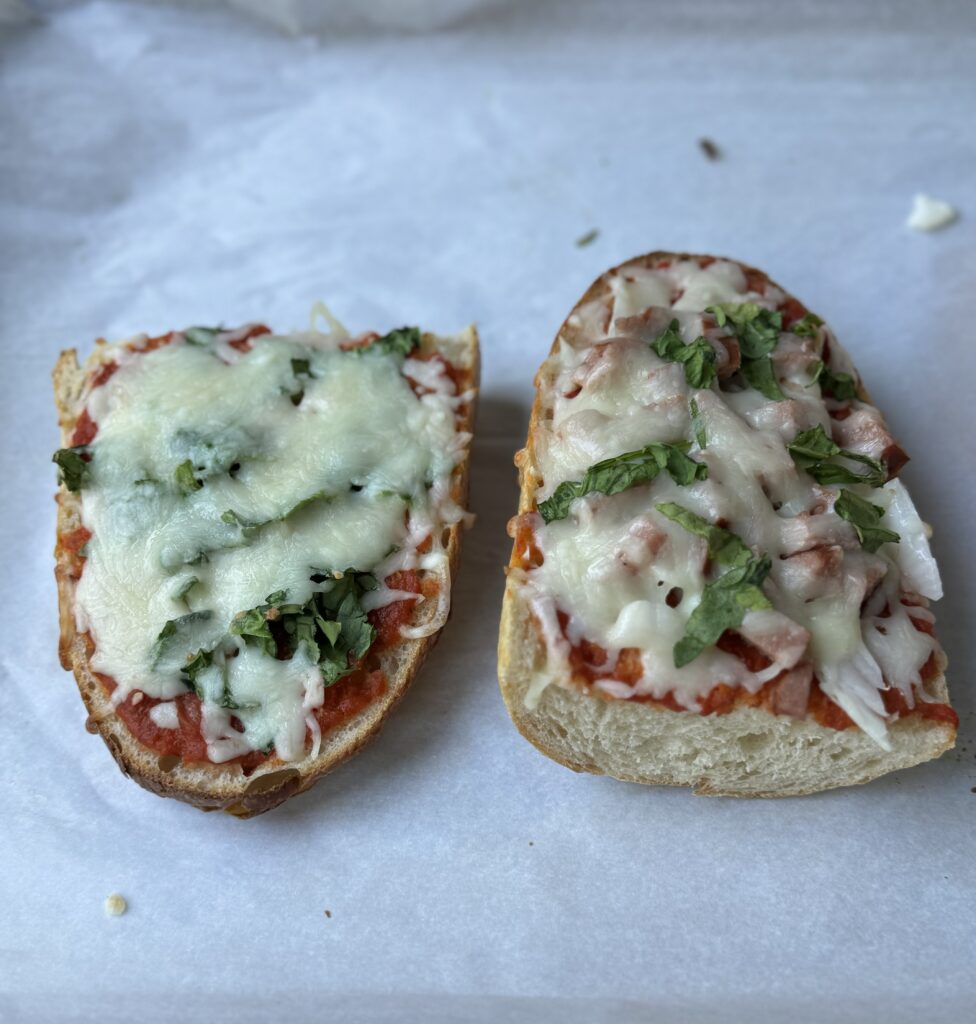
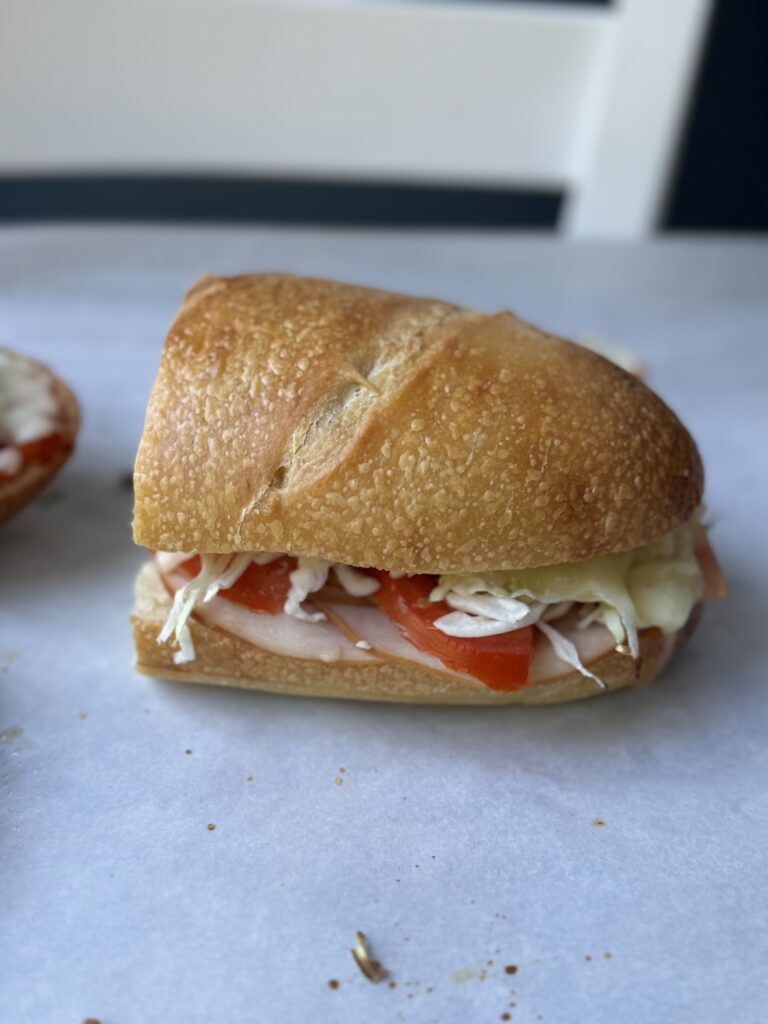
How to make sourdough French bread
Baker’s schedule:
Day 1: Mix the sweet levain the evening before you mix the dough.
Day 2: The following morning, mix the dough and allow it to ferment for 6-7 hours at room temperature (or until doubled in size). Shape the dough and choose from the 3 options below:
1. Place the dough directly in the fridge and complete the second rise on day 2.
2. Let the dough rest for a few hours, place it in the fridge overnight, and remove it from the fridge in the morning to continue the second rise for another few hours (until it triples in size).
3. Let the dough rest for the entire second rise (4-8 hours or until tripled in size) and place in the fridge overnight OR bake the same day.
Day 3: Remove the shaped loaves from the fridge, allow them to rest until tripled in size, and bake.
Timing can vary depending on the temperature in your environment. Watch the dough, not the clock.
Ingredients:
For the sweet levain
- 15 grams of sourdough starter (fed within the past 24 hours)
- 50 grams of water (if using honey decrease to 40 grams)
- 15 grams of sugar or honey
- 50 grams of all-purpose flour
For the dough
- 100 grams of sweet levain (from above)
- 285 grams of water
- 24 grams of sugar
- 500 grams of bread flour
- 28 grams of olive oil
- 10 grams of salt
- For the eggwash: 1 egg and a splash of water
Equipment
- Mixing bowl
- Food scale
- Bench scraper or dough scraper
- Large baking sheet
- Parchment paper
- Rolling pin
Make the sweet levain
- The evening before the dough is mixed, add the sourdough starter, sugar or honey if using, and water to a clean jar. Stir until the starter and sugar dissolve and the water becomes milky.
- Next, add the flour and stir until there are no dry bits of flour left. Loosely cover the jar and allow the levain to rest for 10-12 hours.
Mix the dough
- The following morning dissolve the sweet levain & sugar in the water in a mixing bowl. Whisk using a fork.
- Then add the bread flour, salt, and olive oil. Mix the dough by hand until all of the flour as absorbed the water.
- Cover the bowl with plastic wrap and allow the dough to rest for 30-45 minutes.
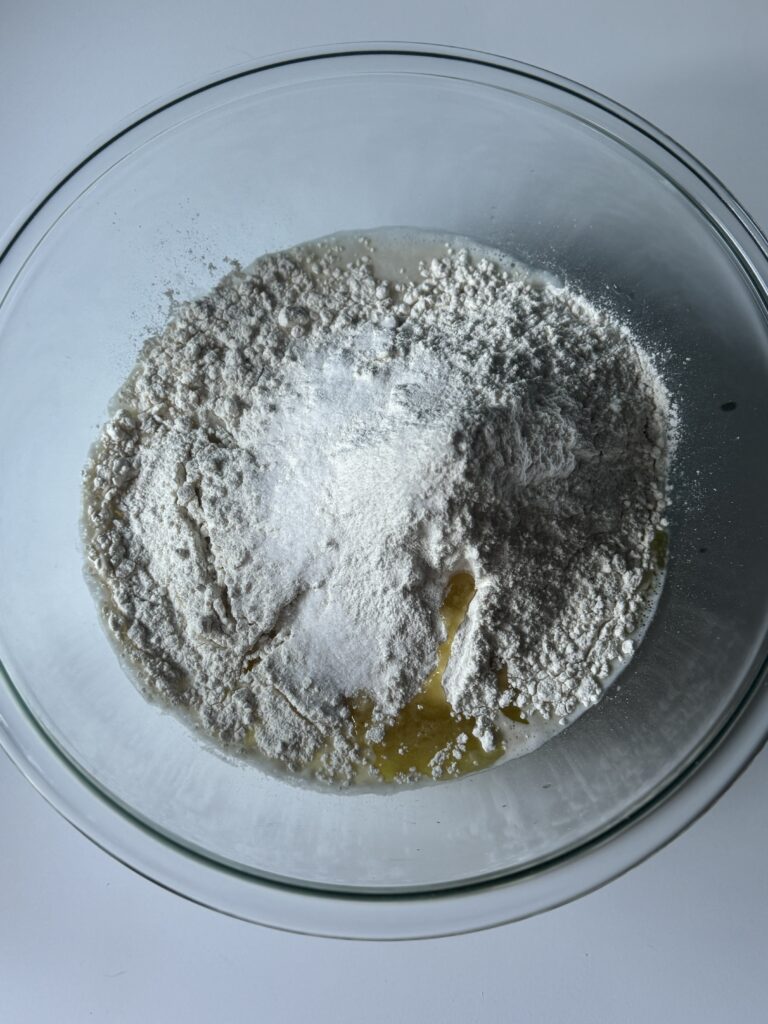
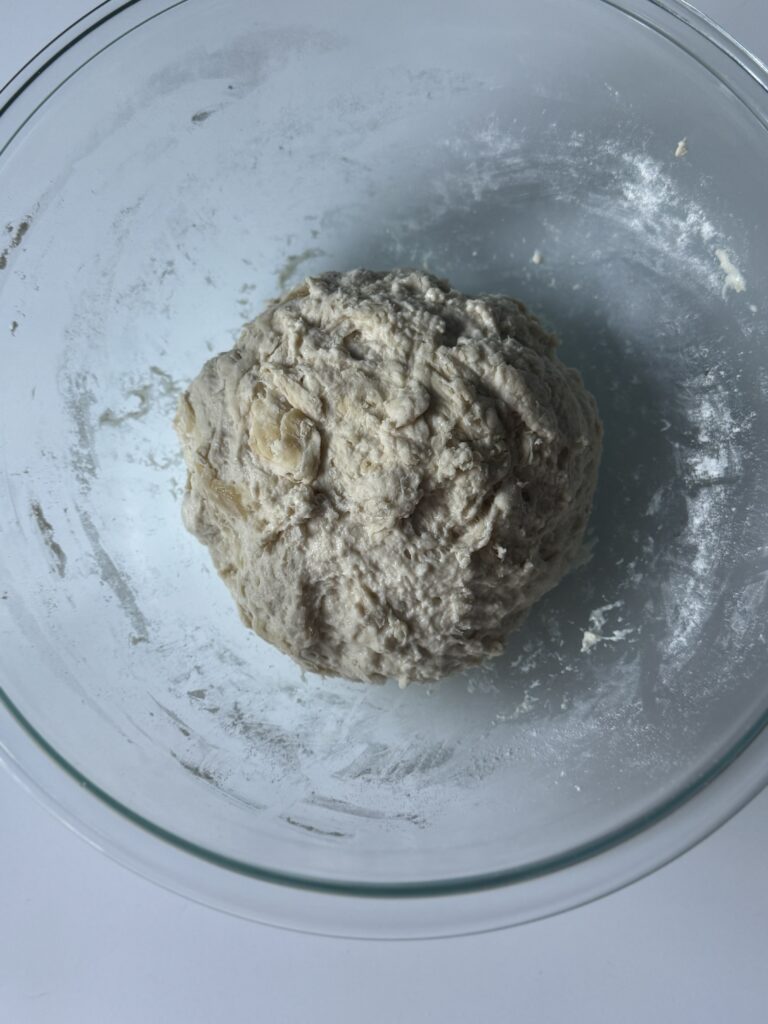
Knead the dough & stretch and folds
- Turn the dough out on a lightly floured surface and knead it by hand for 5-7 minutes or until it comes together and is no longer sticky.
- Place it in an oiled bowl, cover it and let it rest for 30-45 minutes.

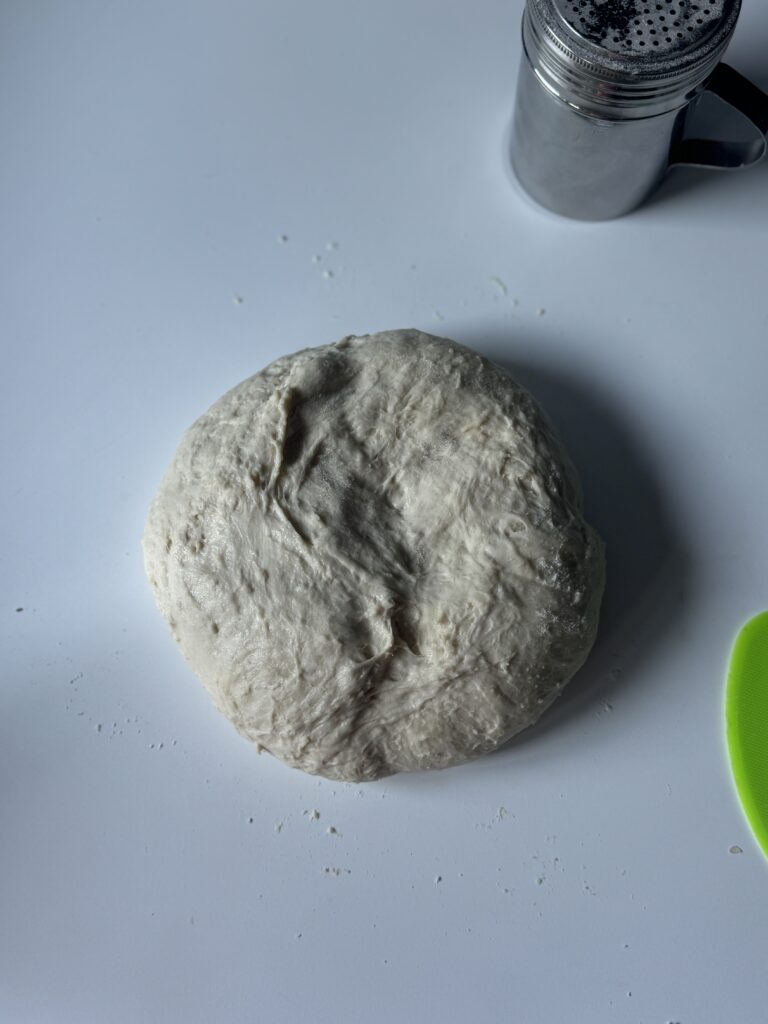

- Perform 3 stretch and folds within 30-45 minute increments. Once complete allow the dough to rest, covered for the remainder of the bulk rise (until it doubles in size). The dough should not sit out longer than 7 hours at room temperature or it will become difficult to shape.
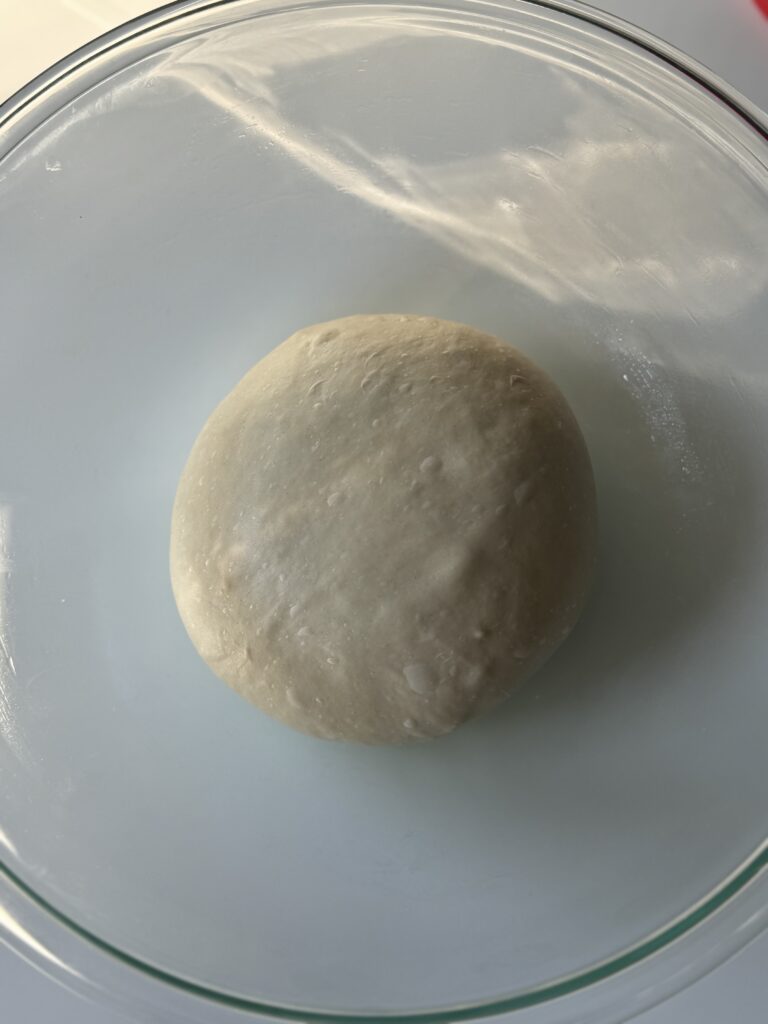
Shape the dough
*Sourdough French bread dough can be refrigerated for up to 24 hours after the first bulk rise.
- After the dough has rested, line a large baking sheet with parchment paper and spray it with non-stick oil.
- Turn the dough out onto a lightly floured surface and divide it into 2 equal portions (I use a food scale for accuracy). Shape each piece into a round ball and let them rest for 10-15 minutes.

- After the dough has rested take each ball and roll it into an approximately 11×7 in rectangle. Use flour as necded.
- Roll each rectangle up from the bottom forming a log shape and tighten the end seams by pinching them together.

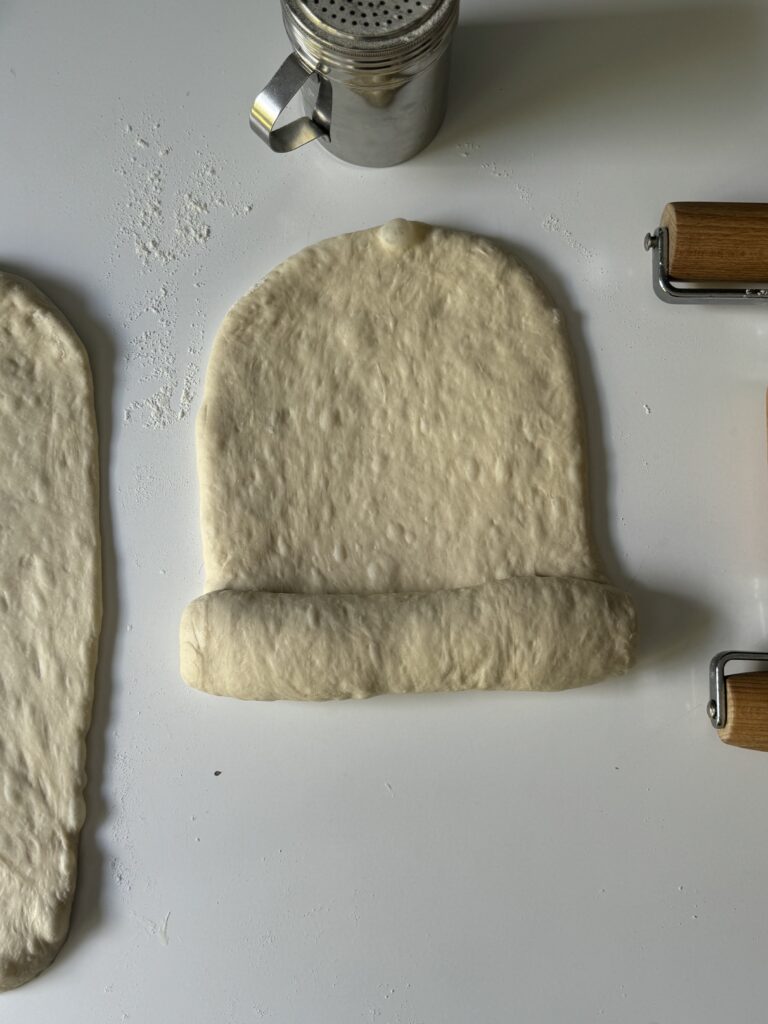
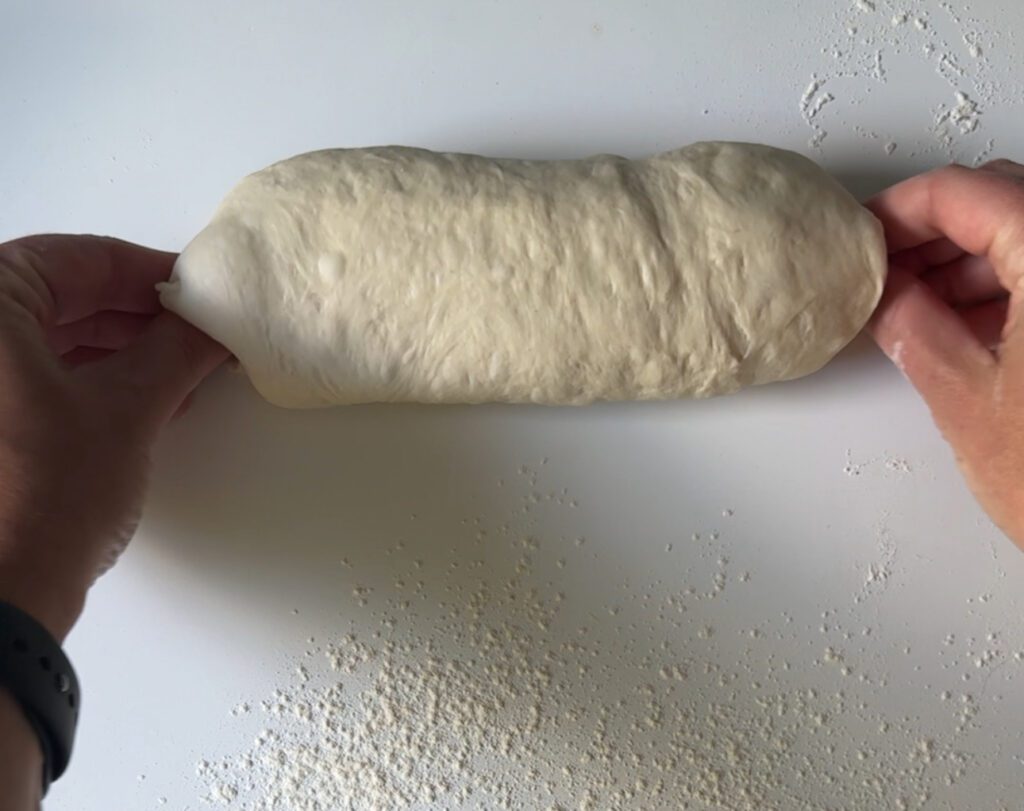
- Place each shaped loaf carefully onto the baking sheet seam side down. Space them a few inches apart to ensure enough room for them to rise.
- Cover the pan with a damp tea towel or oiled plastic wrap.
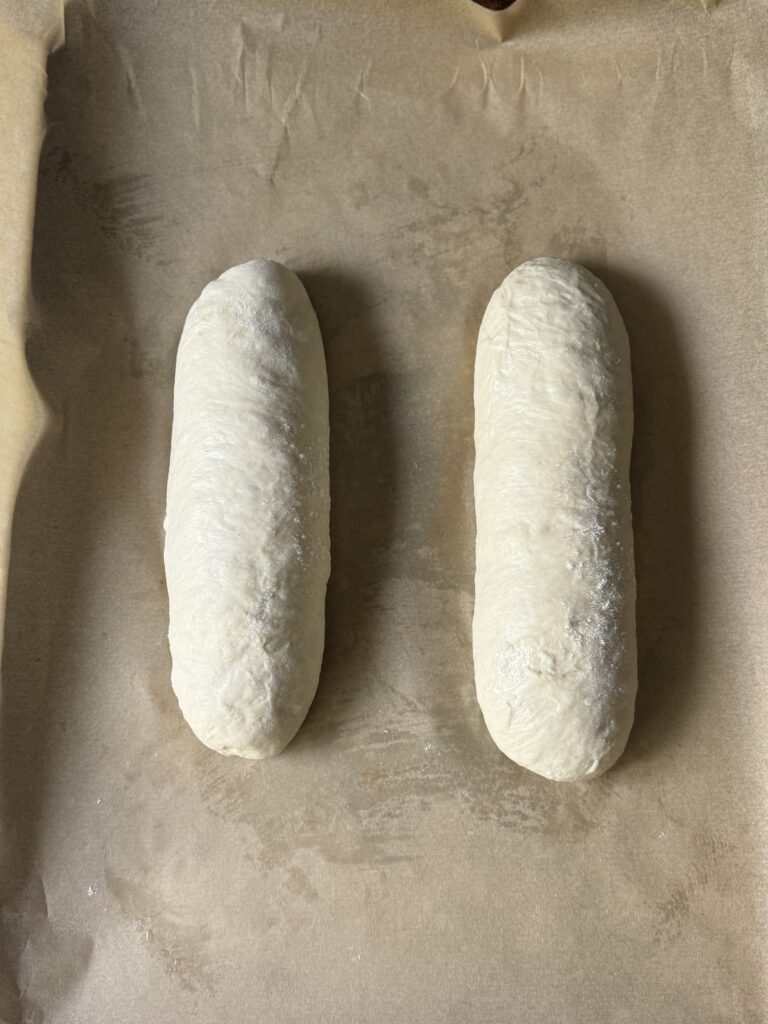
Second Rise
*The dough will need to triple in size before baking (this can take anywhere from 4-8 hours).
After shaping the dough choose from the 3 options below:
1. Place the dough directly in the fridge and complete the second rise on day 2.
2. Let the dough rest for a few hours, place it in the fridge overnight, and remove it from the fridge in the morning to continue the second rise for another few hours (until it triples in size).
3. Let the dough rest for the entire second rise (6-8 hours or until tripled in size) and place in the fridge overnight OR bake the same day.
Refrigerate overnight
Why do we refrigerate the dough? Sourdough French bread obtains optimal flavor from its long fermentation process. It also gives it that classic airy, soft texture.
Proof, score, & Bake
- The following morning remove the shaped loaves from the fridge and let them rest until tripled in size and very puffy.
Why does the dough need to proof for so long? To achieve that classic French bread look and rise it is important that the loaves rest for a solid 4-8 hours ensuring they are puffy enough. Patience is necessary here, I promise it is worth it!
*Timing can vary depending on temperature.
- Once the dough has finished its second rise, preheat the oven to 425 degrees F.
- Place the dough in the freezer for 10-15 minutes to make scoring easier.
- While the dough is resting, whisk together 1 egg and a splash of water.
- Remove the dough from the freezer and brush with the egg wash. Score 3 diagonal lines down each loaf using a bread lame or sharp razor.
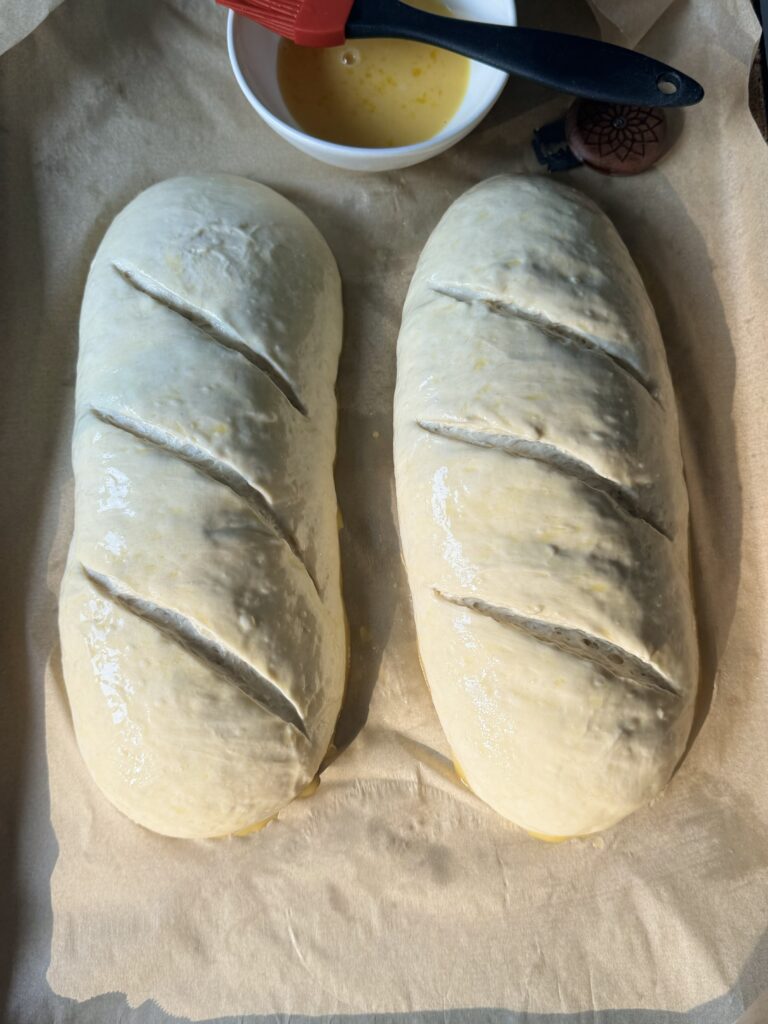
- Bake the sourdough French bread for 25-28 minutes or until it is your desired golden brown. Check the bread at 20 minutes, if the bread is getting too brown cover with foil for the remainder of the time.
*Sourdough French bread is fully baked when it reaches an internal temperature of around 190°F to 210°F
- Upon removing the loaves from the oven brush them with butter for a softer crust.

- Allow sourdough French bread to cool for 1-2 hours before slicing into it.

Storing sourdough French bread
- Any leftover sourdough French bread can be stored in a ziplock bag or bread bag for 3-4 days on the counter.
- How to freeze: sourdough french bread loaves freeze well. Allow the full loaf to cool completely before wrapping it tightly in plastic wrap. Place the wrapped loaf in a large ziplock bag and place in the freezer for up to 3 months!
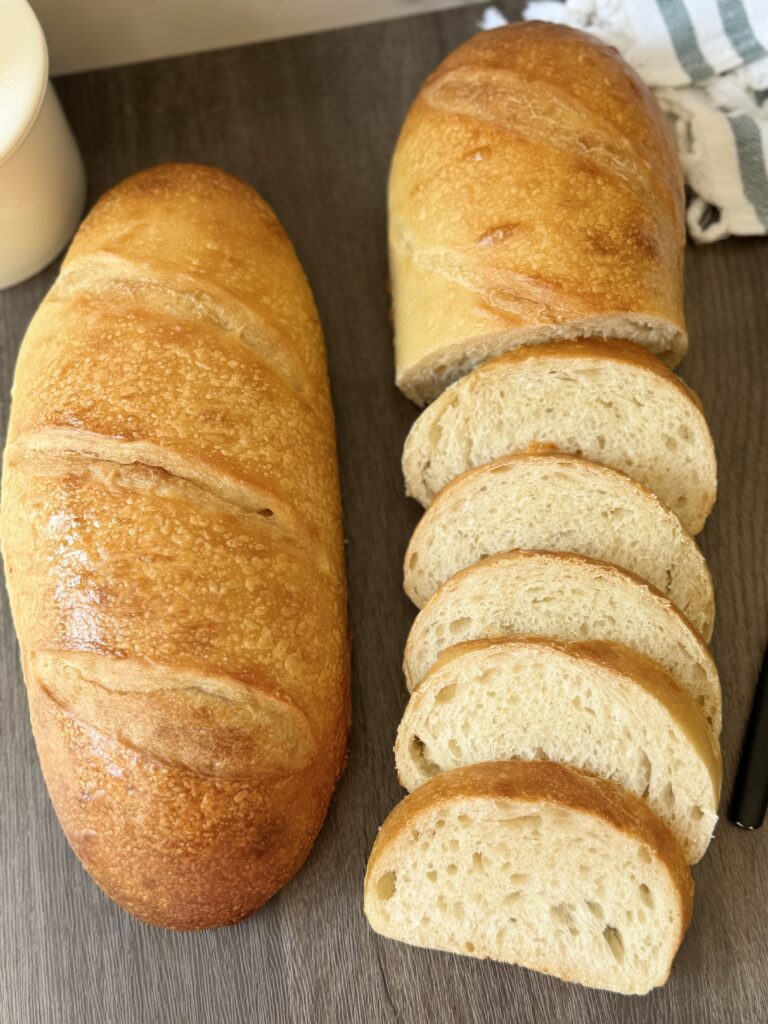
More sourdough bread recipes
- Sourdough Italian Bread
- Simple Sourdough Recipe
- Sourdough Rye Sandwich Bread
- Sourdough Cinnamon Raisin Bread
Sourdough French Bread
Equipment
- Mixing bowl
- Bench scraper
- Scoring tool
- Food scale
- Parchment paper
- Baking sheet
- Rolling Pin
Ingredients
For the sweet levain
- 15 grams sourdough starter fed within the past 24 hours
- 15 grams sugar or honey
- 50 grams water if using honey decrease to 40 grams
- 50 grams all-purpose flour
For the dough
- 100 grams sweet levain from above
- 24 grams sugar
- 285 grams water
- 500 grams bread flour
- 28 grams olive oil
- 10 grams salt
- 1 egg and a splash of water for the eggwash
Instructions
*Read the notes section for the baker's schedule*
Make the sweet levain
- The evening before the dough is mixed, add the sourdough starter, sugar or honey if using, and water to a clean jar. Stir until the starter and sugar dissolve and the water becomes milky.
- Next, add the flour and stir until there are no dry bits of flour left. Loosely cover the jar and allow the levain to rest for 10-12 hours.
Mix the dough
- The following morning dissolve the sweet levain & sugar in the water in a mixing bowl. Whisk using a fork.
- Then add the bread flour, salt, and olive oil. Mix the dough by hand until all of the flour as absorbed the water.
- Cover the bowl with plastic wrap and allow the dough to rest for 30-45 minutes.
Knead the dough & stretch and folds
- Turn the dough out on a lightly floured surface and knead it by hand for 5-7 minutes or until it comes together and is no longer sticky. Use small amounts of flour as needed.
- Place it in an oiled bowl, cover it and let it rest for 30-45 minutes.
- Perform 3 stretch and folds within 30-45 minute increments. Once complete allow the dough to rest, covered for the remainder of the bulk rise (until doubled in size). The dough should not sit out longer than 7 hours at room temperature or it will become difficult to shape.
Shape the dough
- *Sourdough French bread dough can be refrigerated for up to 24 hours after the first bulk rise.
- After the dough has rested, line a large baking sheet with parchment paper and spray it with non-stick oil.
- Turn the dough out onto a lightly floured surface and divide it into 2 equal portions (I use a food scale for accuracy). Shape each piece into a round ball and let them rest for 10-15 minutes.
- After the dough has rested take each ball and roll it into an approximately 11×7 inch rectangle. Use flour as needed.
- Roll each rectangle up from the bottom forming a log shape and tighten the end seams by pinching them together.
- Place each shaped loaf carefully onto the baking sheet seam side down. Space them a few inches apart to ensure enough room for them to rise.
Second Rise
- *The dough will need to triple in size before baking (this can take anywhere from 4-8 hours).
- Cover the pan with a damp tea towel or oiled plastic wrap and choose from the 3 options below: 1. Place the dough directly in the fridge and complete the second rise on day 2. 2. Let the dough rest for a few hours, place in the fridge overnight and remove from the fridge in the morning to continue the second rise for another few hours (until it triples in size). 3. Let the dough rest for the entire second rise (4-8 hours) and place in the fridge overnight OR bake the same day.
Refrigerate overnight
- Why do we refrigerate the dough? Sourdough French bread obtains optimal flavor from its long fermentation process. It also gives it that classic airy, soft texture.
Proof, score, & bake
- The following morning remove the shaped loaves from the fridge and let them rest until tripled in size and very puffy.Why does the dough need to proof for so long? To achieve that classic French bread look and rise it is important that the loaves rest for a solid 4-8 hours ensuring they are puffy enough. Patience is necessary here, I promise it is worth it! *Timing can vary depending on temperature.
- Once the dough has finished its second rise, preheat the oven to 425 degrees F.
- Place the dough in the freezer for 10-15 minutes to make scoring easier. While the dough is resting, whisk together 1 egg and a splash of water.
- Remove the dough from the freezer and brush with the egg wash. Score 3 diagonal lines down each loaf using a bread lame or sharp razor.
- Bake the sourdough French bread for 25-28 minutes or until it is your desired golden brown. Check the bread at 20 minutes, if the bread is getting too brown cover with foil for the remainder of the time.Sourdough French bread is fully baked when it reaches an internal temperature of around 190°F to 210°F
- Upon removing the loaves from the oven brush with butter for a softer crust. Allow sourdough French bread to cool for 1-2 hours before slicing into it.
Storing sourdough French bread
- Any leftover sourdough French bread can be stored in a ziplock bag or bread bag for 3-4 days on the counter.
- How to freeze: sourdough French bread loaves freeze well. Allow the full loaf to cool completely before wrapping it tightly in plastic wrap. Place the wrapped loaf in a large ziplock bag and place in the freezer for up to 3 months!
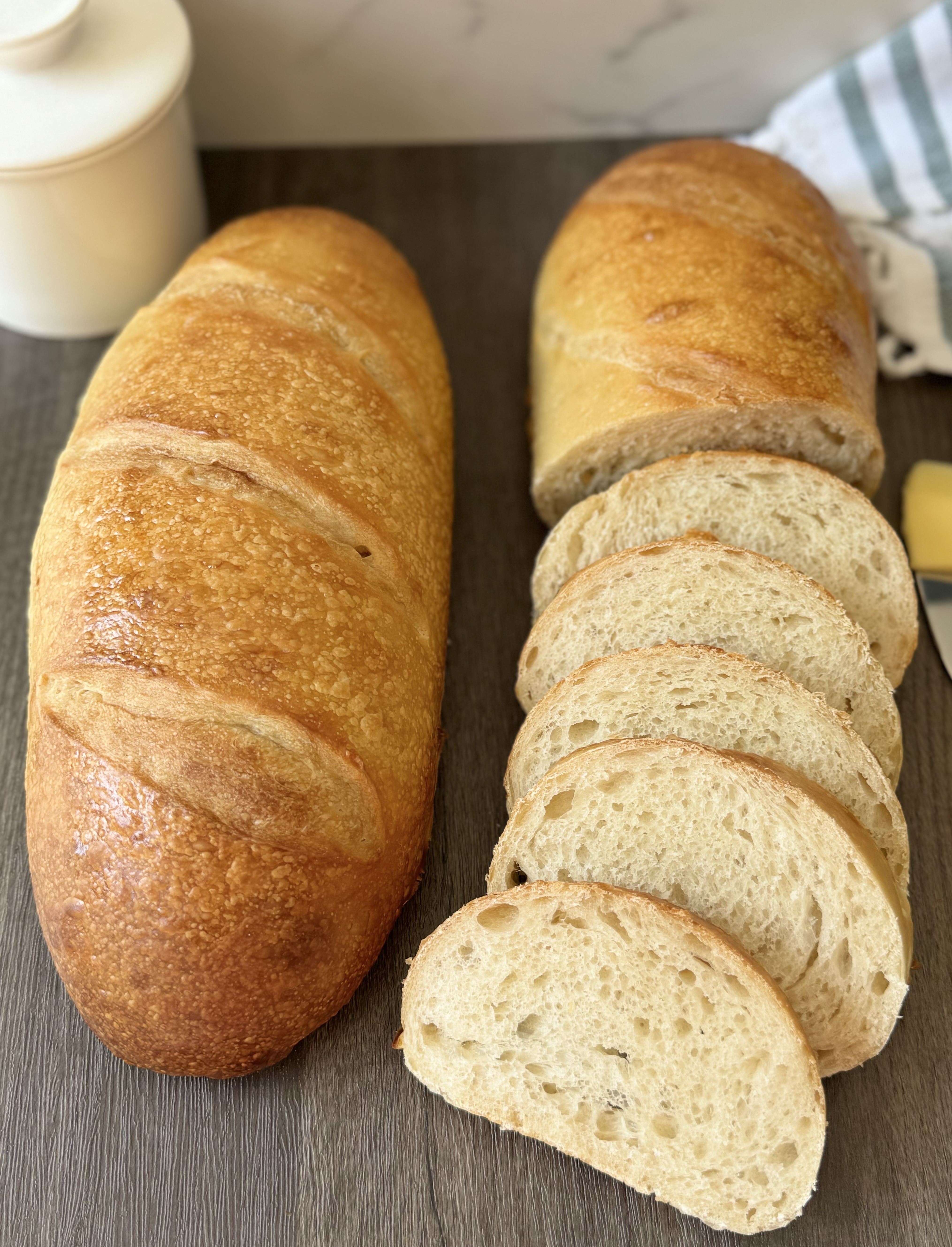
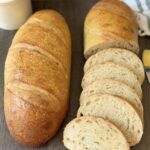
Leave a Comment & Rate the Recipe